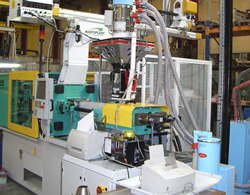Common Needs for Blending/Dosing Equipment

Just about every processor can benefit from investing in blending/dosing equipment. Each of the following methods can provide a rapid return on investment for any processor wanting to improve costs and quality.
Simple regrind with virgin material mix
Processors employing so-called “proportioning valves”, commonly used to layer regrind with virgin material while loading, are not blending but simply timing the irregular flow of regrind and virgin material into the loader. There is no real measuring nor real mixing/blending, so some of your products end up with more regrind – some with less and you may end up using more or less virgin that you want to. That means you do not have control of your costs nor the quality of the product being produced. On the other hand, even a simple, yet highly accurate, 2-component gravimetric blender can pay for itself quickly, even in this simple application.
In-house coloring of virgin material
If you process the same resin or resins every day, but just in different colors, consider what your savings might be if you could meter the exact amount of various colors into your virgin material, on demand. You could reduce your material inventory and purchase your natural resin in bulk – reducing material costs. You could also gravimetrically blend your regrind back in while processing to reduce your consumption of colorants. This scenario plays out over and over with processors who have gotten a payback on their gravimetric blenders in a matter of months!
Tracking Material and Additive Costs
As refined as any manual blending process may be, real control over material consumption and real record keeping are typically left to chance with hopes for careful adherence to procedures. In today’s competitive world, simply hoping that humans always follow procedures is not good enough. The use of true gravimetric equipment that will not only flawlessly perform highly accurate blending functions day in and day out, but also keep track of all material consumption is, in itself, payback for the expenditure. Since every material: virgin, regrind, additives are actually weighed as a part of the gravimetric blending process, reports may be readily summoned that accurately track consumption and can even alert you to re-order points for your supplies. For the savvy processor, this can be accommodated plant-wide or even per job, for true ROI reporting.
Assuring Product Quality
Blending is not only an efficiency to reduce colorant costs and simplify plant processes, but for many processors and many products, highly accurate blending is the key to assuring product performance. Controlling the level of regrind in a critical component can not only effect color matching, but also the strength or weakness of a part. The common mistake of over-dosing color additive (to assure adequate color matching) not only creates unnecessary expense, but can also effect the properties of the product. Wire manufacturers must be concerned about ‘sparking out’ of their wire products from excess colorant. Many processors realize that excess color can change the magnetic and/or electrical properties of their products.
And the ability to show customers reports on actual material vs. additive content, by weight, in every product is very compelling.
Staying Flexible for Varying Feedstock Supplies
In the still very new reclaim product marketplace, a consistent supply of feedstock cannot be assured and processors must be ready to make rapid formulaic changes to accommodate what is available or no longer available. Varying supplies of wood flour, regrind, flake, and other recycled content is often seized upon to be included in products that boast recycle content. Processors need equipment that can be quickly re-aligned for a changing feedstock supply. Gravimetric blenders are typically huge problem solvers for this class of processor with their ability to not only permit simple entry of new recipes but also retain past recipes that can be called upon to be run again. The fact that the blender is actually weighing all of the ingredients in each mix reduces the engineering strain of complex calculations and no calibration is required.
Multi Ingredient Processing Demands
Sometimes, certain processors – like those extruding wood/plastics composites require blending of up to 12 ingredients; some with throughputs up to 8,000 lb./hr. In the past, this would represent a truly unusual blender, equipped with an array of feeders and accessories to accurately feed a variety of raw materials like pellets, wood flour, powders, colorants and additives for weather-ability, flexibility and a host of other properties. No more. Blenders with this functionality are now available “off the shelf” in a wide array of possible configurations ready to serve this portion of the plastics marketplace. Read more



